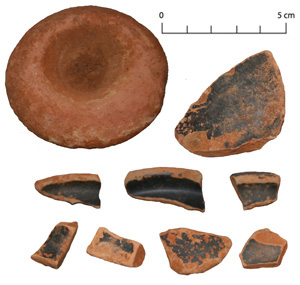Ελληνικά

under the aegis of the Canadian Institute in Greece and the Hellenic Ministry of Culture

Hellenistic pottery from a hilltop site north of Kantiliana: a) an amphora base (possibly Samian) and b) fragments of several black glaze kantharoi. Photograph by Y. Kozatsas.
By far the most impressive archaeological site on the island is the fortified Hellenistic town now known as the Kastro. The town covers some 7 hectares and both ceramic and numismatic evidence suggests a life-span from the late 4th to mid 1st century BC. Both the town and the island appear to have been known as Aegila (or Aegileia) during the Classical-Roman period and Hellenistic Aigila appears in the written records as a pirate community whose activities prompted several significant military responses, including an attack by a Rhodian fleet in the 3rd century BC and a final sack by the Roman fleet in 67-69 BC. The Kastro is the subject of annual excavations (a separate project directed by ASP's Greek synergast, Aris Tsaravopoulos; see Martis et al. 2006) that has uncovered multiple construction phases for the fortifications, a rock-cut ship-shed, a temple to Apollo at the Xeropotamos harbour site, and both archaeological and inscriptional evidence for Aegila's wider cultural, economic and political affiliations (see also Martis et al. 2006).

Lamp from the south of Charchaliana, with reddish-brown slip and mould-made inscription (...ENEI PA SI…). Photograph by S. ONeill.
After the end of the Kastro community, there seems to be much less material from the succeeding Roman period (though this is a critical area where further study of our finds is necessary), but cist graves of 5th-7th century AD date have been excavated as part of separate project led by Aris Tsaravopoulos (see Pyrrou et al. 2006) and now can be complemented by the survey evidence which indicates that Late Roman pottery is abundant on the island, with a low density spread of material across the more fertile parts of the landscape, and perhaps half a dozen denser scatters. The latter are probably small, permanent communities who were consuming and discarding an interesting range of ceramic coarsewares, storage jars with comb decoration, slipped tablewares and glass and we look forward to exploring these patterns in more detail as study progresses.
Martis, T. and Zoitopoulos, M. and A. Tsaravopoulos 2006 'Antikythera. The Early Hellenistic Cemetery of a Pirate's Town', in S. A. Luca and V. Sîrbu (eds.) The Society of the Living - the Community of the Dead (from Neolithic to the Christian Era). Proceedings of the 7th International Colloquium on Funerary Archaeology: 125-134. Sibiu: Bibliotheca Septemcastrensis. (full text of edited volume, 15.8 MB pdf)
Pyrrou, N., Tsaravopoulos, A. and C. O. Bojica 2006 'The Byzantine Settlement of Antikythera (Greece) in the 5th-7th Centuries', in S. A. Luca and V. Sîrbu (eds.) The Society of the Living - the Community of the Dead (from Neolithic to the Christian Era). Proceedings of the 7th International Colloquium on Funerary Archaeology: 224-236. Sibiu: Bibliotheca Septemcastrensis. (full text of edited volume, 15.8 MB pdf)